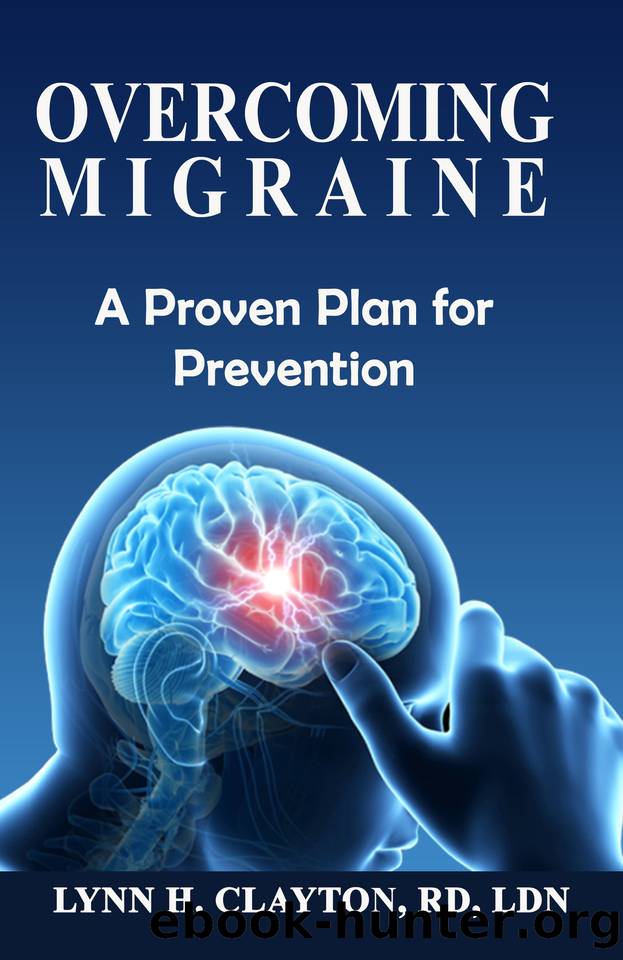Overcoming Migraine: A Proven Plan for Prevention by Clayton Lynn

Author:Clayton, Lynn [Clayton, Lynn]
Language: eng
Format: epub
Publisher: Clayton Nutrition
Published: 2020-08-22T16:00:00+00:00
Seven
Pharmaceutical Treatment of Migraine
After identifying and eliminating all known triggers, you still get a migraine. Now what? Life happens and we cannot control everything. Knowing what to do whenever a migraine hits is just as important as trying to prevent one. In this chapter, we will discuss treatment options for migraine attacks. Whether you have occasional or chronic migraines, getting proper treatment is important. Allowing the pain to perpetuate does not help your physical or psychological well-being and can lead to a vicious cycle of pain. Fortunately, there are more options today than we had just five years ago. As research continues, hopefully we will have more options available. In this chapter, we will explore pharmaceutical options currently available for the treatment of a migraine attack as well as preventive treatments for chronic migraine management.
It is believed there are many contributing factors to migraine, so it makes sense that one medication may work for some but not for everyone. Finding what works for you can be a game of trial and error. Working with a caring, compassionate health professional can get you help quicker. If one medication is not working, let your healthcare provider know so they can try something else. Always discuss any concerns you may have with them. Some medications may not be recommended for you due to your medical history or family history. Also, some medications can interact with others, so your doctor or pharmacist can discuss the risks and determine what is best for you. Even if you are taking over-the-counter medications to treat a migraine, you may want to consult a specialist to see if there are better options, especially if you are not getting the results you desire.
Medications
There are two primary forms of medications used in migraine treatment: acute and preventive. Acute medications are used to treat a migraine attack by relieving pain and helping to stop the migraine from progressing. Preventive medications are used if migraines are chronic (occurring at least eight days per month) to help reduce the frequency or at least shorten the duration of migraines.
Acute Medications
There are three classes of migraine medications primarily used to treat a migraine attack. These include prescription and over-the-counter medications. While other supportive medications may be given to alleviate symptoms such as nausea during a migraine, we will focus on the main three used in acute migraine treatment.
Analgesics
These pain relievers include acetaminophen (Tylenol®), and a class of drugs known as non-steroidal anti-inflammatories (NSAIDs) like ibuprofen (Advil®, Motrin®) and diclofenac potassium (Cambia®). These are available either over the counter or as a prescription. Some will include caffeine due to its vasoconstrictive properties, which may help them work better. Another option includes opioids like hydrocodone (Vicodin®). These drugs use an opioid combined with another pain-relieving drug such as acetaminophen.
These medications do not treat the cause of migraine but help reduce inflammation and lessen the associated pain to make the patient more comfortable until migraine runs its course. These are most effective for mild to moderate migraine pain.
Download
This site does not store any files on its server. We only index and link to content provided by other sites. Please contact the content providers to delete copyright contents if any and email us, we'll remove relevant links or contents immediately.
| Administration & Medicine Economics | Allied Health Professions |
| Basic Sciences | Dentistry |
| History | Medical Informatics |
| Medicine | Nursing |
| Pharmacology | Psychology |
| Research | Veterinary Medicine |
Periodization Training for Sports by Tudor Bompa(7921)
Why We Sleep: Unlocking the Power of Sleep and Dreams by Matthew Walker(6357)
Paper Towns by Green John(4800)
The Immortal Life of Henrietta Lacks by Rebecca Skloot(4257)
The Sports Rules Book by Human Kinetics(4078)
Dynamic Alignment Through Imagery by Eric Franklin(3920)
ACSM's Complete Guide to Fitness & Health by ACSM(3824)
Kaplan MCAT Organic Chemistry Review: Created for MCAT 2015 (Kaplan Test Prep) by Kaplan(3801)
Introduction to Kinesiology by Shirl J. Hoffman(3626)
Livewired by David Eagleman(3534)
The River of Consciousness by Oliver Sacks(3418)
The Death of the Heart by Elizabeth Bowen(3340)
Alchemy and Alchemists by C. J. S. Thompson(3294)
Descartes' Error by Antonio Damasio(3166)
Bad Pharma by Ben Goldacre(3097)
The Emperor of All Maladies: A Biography of Cancer by Siddhartha Mukherjee(2930)
The Gene: An Intimate History by Siddhartha Mukherjee(2927)
The Fate of Rome: Climate, Disease, and the End of an Empire (The Princeton History of the Ancient World) by Kyle Harper(2873)
Kaplan MCAT Behavioral Sciences Review: Created for MCAT 2015 (Kaplan Test Prep) by Kaplan(2815)
